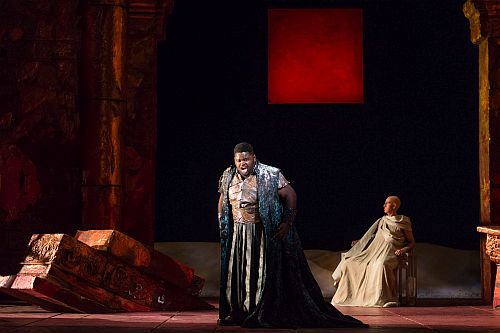 United States Vivaldi: Catone in Utica, Glimmerglass Festival Orchestra, Alice Busch Opera Theater, Glimmerglass, New York, 18.7.2015 (SSM)
United States Vivaldi: Catone in Utica, Glimmerglass Festival Orchestra, Alice Busch Opera Theater, Glimmerglass, New York, 18.7.2015 (SSM)

American Premier
Cast:
Cato: Thomas Michael Allen
Marzia: Megan Samarin
Fulvio: Allegra De Vita
Arbace: Eric Jurenas
Emilia: Sarah Mesko
Caesar: John Holiday
Production:
Conductor: Ryan Brown
Director: Tazewell Thompson
Choreographer: Anthony Salatino
Scenery: John Conklin
Costumes: Sara Jean Tosetti
Lighting: Robert Wierzel
For years I confused Glimmerglass with Glyndebourne. I would attend performances at the New York City Opera that were new productions and notice in the Playbill that the NYCO had been working jointly with Glimmerglass (or Glyndebourne) on creating them. In fact, there were more than twenty joint productions between the NYCO and Glimmerglass. Baroque opera thrived in New York during the nine years that Paul Kellogg ran the NYCO; before that, Kellogg had been with Glimmerglass during three of its most important decades.
In preparation for attending this first American production of Vivaldi’s Catone in Utica, I went through the opera’s history and found Act I such a mishmash of lost, replaced or borrowed music that I had to lay out the opening act on a spreadsheet according to the source of each aria. In the two complete versions that were available to me (a third version exists but is prohibitively expensive), each had its own way of accounting for the missing arias. One version, from a 2001 performance by Jean-Claude Malgoire, filled out Act I with borrowings from other Vivaldi operas. Another edition (the one used at Glimmerglass, by the late conductor and Baroque scholar Alan Curtis) replaces the lost Act I with music adapted by Alessandro Ciccolini. It also includes one aria from Rosmira Fidele, thought to have been originally in Catone in Utica.
Reconstruction is pretty much the norm with Vivaldi: only eleven of the thirty or more operas that have been unearthed are complete. But there is no real reason to skip scenes or whole acts just because they are incomplete. If that attitude were taken towards the wonderful Vivaldi operas (really pastiches) Bajazet, Montezuma and Andromeda Liberata it would be a great loss. It’s better to hear plugged-in, borrowed arias from other Vivaldi operas than to have nothing at all. Ciccolini, in fact, made very workman-like additions to the missing arias in Catone; he also took two arias from the unperformed Act I and used them for the added suicide scenes.
In the end, my spreadsheet was not needed as Act I was not to be performed. We were told before the start by conductor Ryan Brown that Act I had nothing much to say and could be summed up in a few short texts projected on scrims. We were also informed that there would not be the happy ending Vivaldi wanted in place of librettist Metastasio’s tragic finale.
Gone are the days when an orchestra is belittled for attempting to play Baroque-era operas on non-period instruments. But one does expect an effort to at least emulate the sound by lessening vibrato. This should be particularly true of Ryan Brown whose specialty is Baroque opera. Throwing in a therebo just doesn’t do it. The end result was a performance that lacked the spirit of Vivaldi. From the first notes of the overture, a sinfonia taken from Vivaldi’s L’Olimpiade, the tonal color was bland.
As it should be, the singers were the stars of the show, and smart choices were made in the selection of voices. This is not easy music, and the production people wisely chose professionals for the elaborate arias, particularly those with serpentine melismas and cadenzas. Among the students in the cast, Eric Jurenas excelled as the unwanted suitor, Arbace. Thomas Michael Allen as Cato did not have enough vocal material to show his strengths but brilliantly acted the role of Cato. Sarah Mesko blew me away with the aria “Come invano il mare irato,” running through two octaves as if it was child’s play.
I last saw countertenor John Holiday in 2013 as Radamisto in a student production at the Juilliard School, and what I said then could be applied here:
“His rich, natural, unforced voice never sounded false, and the ease with which he expressed all kinds of emotions was first-rate. His voice was equally impressive in arias that required dramatic strength, such as the show-stopping ‘Vile! Se mi dai vita’ with its long and difficult melissmas [read ‘Se mai senti spirarti sul volto lieve’ in Catone].”
Ryan Brown kept the da capo structures that were standard for the era. Many people find the A-B-A form difficult to sit through, and this is particularly true with Handel’s long arias. Vivaldi’s arias, on the other hand, are quick and tidy, and give the vocalist opportunity to improvise in the repeats.
Stan Metzger
Note: There has not been much mention of the sudden and recent death of the great reviver of Italian Baroque opera, Alan Curtis. With his group “Il Complesso Barocco” he reconstructed many Baroque operas, including Vivaldi’s Catone in Utica. Curtis and his counterpart in France, William Christie, are American-trained harpsichordists who became residents of two musically rich countries, and both have done much to revive early music. His absence is a grave loss to the music world.
This was a truly thrilling and perfect production. The orchestra was as wonderful as the singers.
I was not been able to identify each of the instruments and would be grateful for that information.
Thank you for a beautiful afternoon and kudos for the entire company.